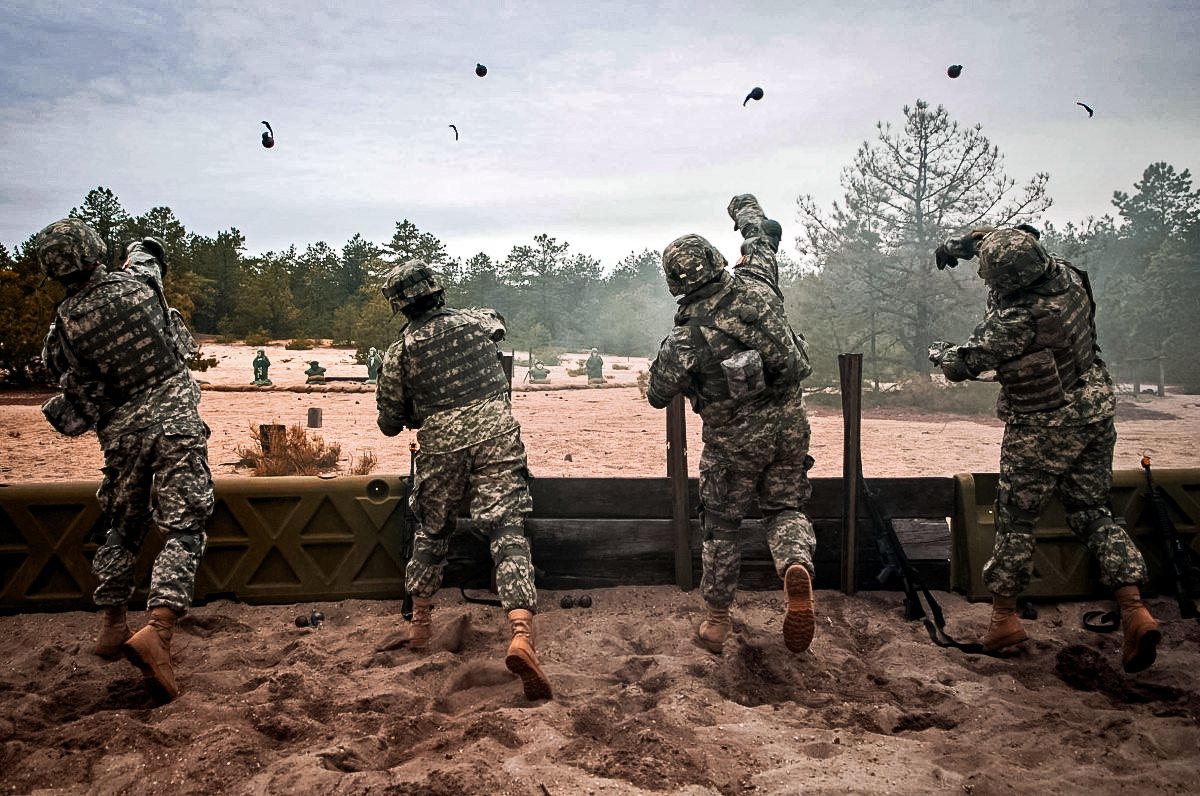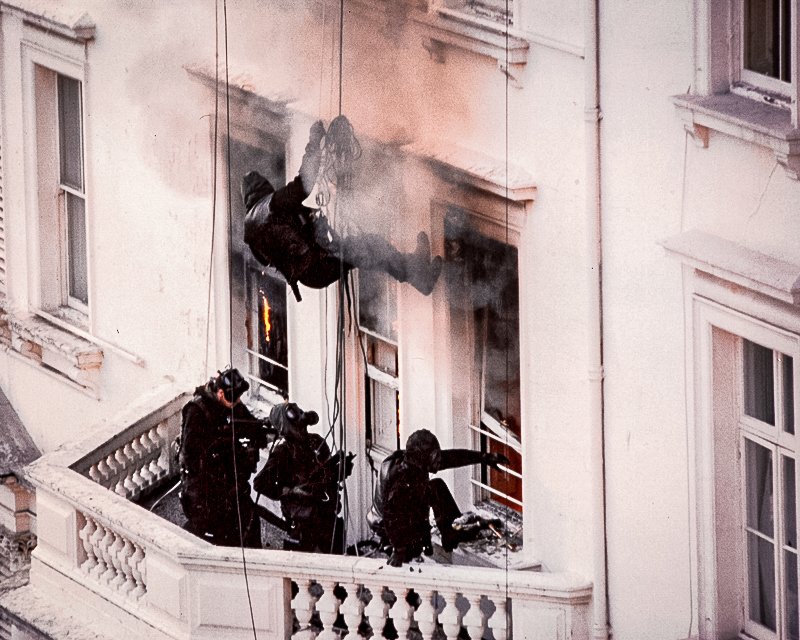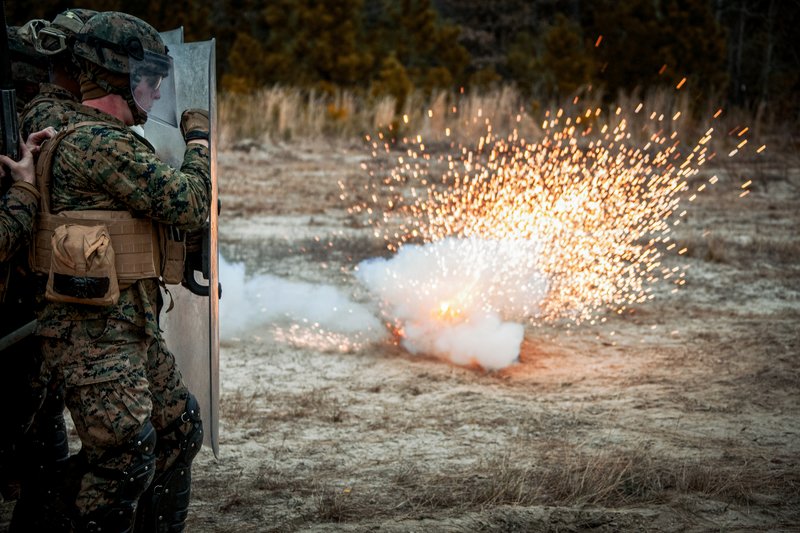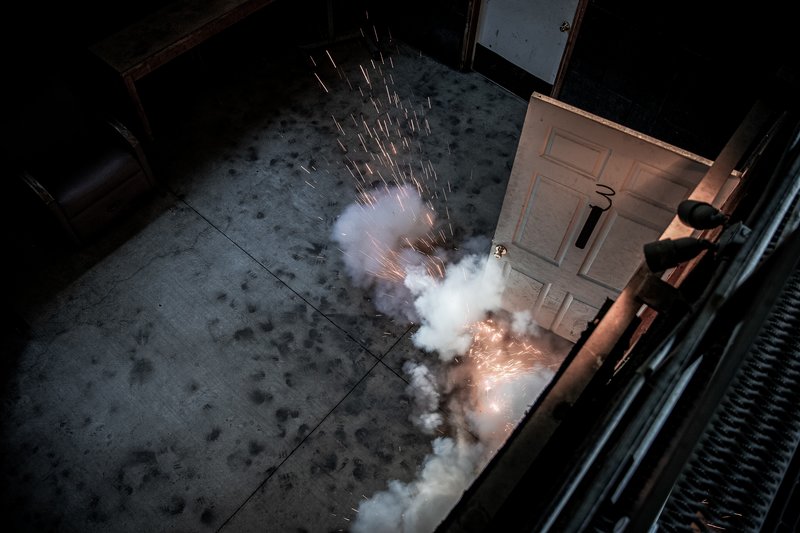
US Army soldiers participating in hand grenade training in 2012. Fragmentation hand grenades are used for deadly force while flash grenades are typically used for preserving life. US Army photo
On April 30, 1980, six gunmen overran the Iranian Embassy in London and took hostages. A tense, six-day standoff followed. Negotiators from London’s Metropolitan Police Department pleaded with the captors for a safe resolution. Journalists and other media eagerly waited, armed with videocameras to cover the unfolding events.
The police learned that the terrorists belonged to the Democratic Revolutionary Front for the Liberation of Arabistan, or DRFLA, a splinter group seeking independence from Iran. The DRFLA demanded the release of 91 Arabs imprisoned in Iran’s Khuzestan province. If they were not released, the terrorists would blow up the embassy. On day six, the terrorists killed a hostage and threatened to kill more.
The British police turned to their top-secret counterterrorism team — 22 Special Air Service, or SAS — for a solution. Five SAS teams positioned explosive charges on six entry points before commencing their assault. Before they got the order to go, however, an SAS trooper rappelling from the roof accidentally kicked his foot through a window.

Flashbangs were developed for the British SAS in the 1970s and were used during the now-iconic Iranian Embassy Siege in London in 1980. Photo courtesy of Britain's National Army Museum.
“We still had the element of surprise because although the terrorist leader had heard a noise, he still hadn’t discovered the cause,” Cpl. Robin Horsfall, an SAS trooper on the mission, told Coffee or Die via email. “However, we had to suddenly hurry.”
News cameras captured SAS members leaping over the balcony, slamming their explosive frame charge on the window, and initiating the explosion to make entry. The other teams used sledgehammers to smash through doors. The SAS assaulters hurled flash bangs inside.
The loud, disorienting booms and whistles distracted the terrorists long enough to eliminate all but one — bringing an end to the Iranian Embassy Siege. Flashbangs were new equipment at that time but are now considered essential in elite military special operations teams and federal law enforcement tactical units.
Related: Why Chris Ryan Credits Training For Survival of Longest Escape And Evasion in British History
What Is a Flashbang?

Marines with Battalion Landing Team 1st Battalion, 6th Marine Regiment, 22nd Marine Expeditionary Unit, were hit by random objects such as batons and flashbangs during a non-lethal weapons course at Marine Corps Base Camp Lejeune, North Carolina, Jan. 22, 2016. US Marine Corps photo by Cpl. Chris Garcia.
A flashbang is a diversionary device typically thrown into small, confined spaces to disorient people’s senses. The most common flashbangs are 1-bang, 2-bang, and 9-bang, which discharge bright flashes, ear-piercing whistles, and thunderous bangs.
According to the American Journal of Operations Research, these loud noises register at 170 decibels or more. For context, that’s approximately 30 decibels more than a jet engine.
The detonation of a flashbang — also called a flash grenade or a stun grenade — may cause flash blindness, temporary deafness, or loss of balance.
Related: The M203 Grenade Launcher: Farewell to Infantry’s ‘Little Friend’
Who Uses Flashbangs?

Members of a US Special Forces assault team wait as a flashbang goes off before entering an abandoned building, where a known high value target is hiding out, during a kill-or-capture training mission in Germany, Feb. 23, 2010. US Army photo by Sgt. 1st Class Silas Toney.
Most military special operations forces worldwide use flashbangs. The equipment is typically carried by assaulters for targeted raids or hostage rescue missions, like the Iranian Embassy Siege. In addition, federal law enforcement tactical teams also frequently use flashbangs.
One well-known incident occurred during the manhunt for the Boston Marathon bombers in Watertown, Massachusetts, in April 2013. A resident alerted the police after discovering blood stains on his boat in his backyard. The police determined Dzhokhar Tsarnaev, one of two surviving terrorists, was hiding inside.
The FBI’s Hostage Rescue Team arrived and took control of the scene. They were cautious in their approach because hours earlier the bombers had thrown improvised explosive devices and pipe bombs at police. It was possible Tsarnaev had a rifle or wore a suicide vest.
Eventually, the FBI team leader decided to try to take Tsarnaev alive. His team hurled four or five flashbangs into the boat. The disorienting effects of the flashbangs, combined with police negotiators on the scene, prompted Tsarnaev to surrender.
Related: Why the ‘Commando’ Quad-Tube Rocket Launcher Replaced the Flamethrower
Can Flashbangs Cause Serious Injuries?

US Marines with Special Reaction Team, Provost Marshall’s Office, Marine Air Ground Task Force Training Command, throw an M84 stun grenade during a live-fire shoothouse training at the Los Angeles Police Academy, Jan. 21, 2021. US Marine Corps photo by Lance Cpl. Joshua Sechser.
Many local and state police departments no longer use flashbangs for liability reasons. According to research published in 2015 by ProPublica, at least 50 Americans had been seriously injured, maimed, or killed by flashbangs between 2000 and 2015.
In 2004, three FBI agents were seriously injured when a defective flashbang attached to one of the agents’ bulletproof vests went off unexpectedly. The agents were in a vehicle at the time of the detonation, and each suffered a concussion and hearing loss.
Flashbangs are also inherently dangerous to children. In 2014, during a botched SWAT raid in Georgia, a 19-month-old child was severely injured when a flashbang exploded in his crib. The child suffered severe first- and second-degree burns to his mouth, nose, and chest, as well as a fractured jaw. Ultimately, the family reached a settlement of more than $3 million.
Related: 5 American Badasses Who Dove on Grenades — and Survived
Are Flashbangs Legal?

The most common types of flashbangs are 1-bang, 2-bang, and 9-bang. Photo by Sgt. Anshu Pandeya.
Flashbangs produced for military and law enforcement are classified as destructive devices by the Bureau of Alcohol, Tobacco, Firearms, and Explosives. This classification means they are not available on the commercial market.
However, some companies like IWA International Inc. sell diversionary devices similar to flashbangs, classified as pyrotechnics. Buyers must have a professional pyrotechnician registration and explain their useful purpose. Some examples of the legal use of pyrotechnics include law enforcement training, the film industry, and paintball or airsoft war games.
Read Next: ‘The Pink Panthers’: Why the British SAS Used To Paint Their Camouflaged Land Rovers Pink

Matt Fratus is a history staff writer for Coffee or Die. He prides himself on uncovering the most fascinating tales of history by sharing them through any means of engaging storytelling. He writes for his micro-blog @LateNightHistory on Instagram, where he shares the story behind the image. He is also the host of the Late Night History podcast. When not writing about history, Matt enjoys volunteering for One More Wave and rooting for Boston sports teams.
BRCC and Bad Moon Print Press team up for an exclusive, limited-edition T-shirt design!
BRCC partners with Team Room Design for an exclusive T-shirt release!
Thirty Seconds Out has partnered with BRCC for an exclusive shirt design invoking the God of Winter.
Lucas O'Hara of Grizzly Forge has teamed up with BRCC for a badass, exclusive Shirt Club T-shirt design featuring his most popular knife and tiomahawk.
Coffee or Die sits down with one of the graphic designers behind Black Rifle Coffee's signature look and vibe.
Biden will award the Medal of Honor to a Vietnam War Army helicopter pilot who risked his life to save a reconnaissance team from almost certain death.
Ever wonder how much Jack Mandaville would f*ck sh*t up if he went back in time? The American Revolution didn't even see him coming.
A nearly 200-year-old West Point time capsule that at first appeared to yield little more than dust contains hidden treasure, the US Military Academy said.












